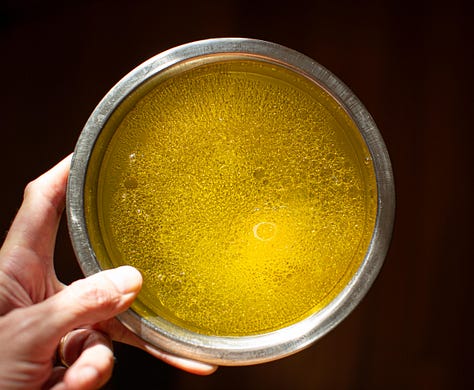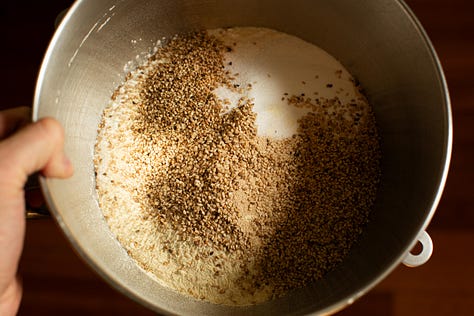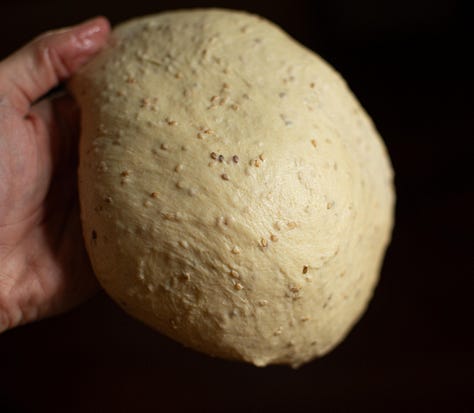As I type, the sun has returned to Vermont. Apple and pear trees in the yard are exploding blossoms and no-mow May has our grass looking like an “Emo” haircut. Cool weather yesterday stirred some desire for a fire in the woodstove, but we’re holding out. Hoping for continued warming, and sun. These yellow loaves work wonders while we wait.
Last Sunday I woke up with two thoughts. One, I want fresh bread. And two, a rebuttal to the first, “you didn’t set a preferment.” This happens. You’ve been there. While the situation is a great prompt for Mama’s Bread, a basic baguette (with no preferment), biscuits, or plenty of other bakes, I craved a specific loaf: a large, s-shaped spiral, coated with sesame seeds in the style of a “pane Siciliano.” The interior of my imagined loaf would be buttery yellow from durum wheat and speckled with toasted sesame seeds. After slicing, the crumb would shred like brioche inside a thin, crisp, nutty shell of a crust as darkly golden as the color of fried chicken.
So I wrote a recipe. Not too much water, a blend of bread flour and semolina (I’d love to use durum flour — the deep yellow flour made from the same durum wheat as semolina — but it’s not widely available and semolina will bring at least some of the yellow color that I want), a generous portion of olive oil for tenderness, toasted sesame seeds, and an egg. While the egg that I added for keeping quality and tenderness is a slight departure from traditional pane Siciliano, I promise you that your nonna will be back for a second slice. And you will, too. Let’s make it.
Sesame-Semolina (Pane Siciliano)
Yield: Two large loaves or one loaf plus sandwich rolls
Bread flour (12.7% protein), 683g
Semolina, 171g
Salt, fine, 21g (1 T plus 1/2 t)
Yeast, instant, 9g (1 T)
Water*, 486g
Sugar, 43g
Egg, whole, 50g (one room temperature medium egg)
Olive oil, 85g
Sesame seeds, 51g, (plus additional for the crust)
*For the sesame seeds, I like the unhulled ones if you can find them. For a maximum nutty flavor, toast the sesame seeds briefly in a dry pan until they heat and begin to pop. Cool before adding to the mix.
*For the water temperature, in cool months with flour temperatures in the 60s, warm your water to 85 to 95°F or so. In warmer months, 75 to 80°F should be good.



Mix:
Combine everything in the bowl of a stand mixer fitted with a dough hook. Mix on low speed until the mixture is homogeneous. Increase the speed to medium low (speed three in a KitchenAid) and mix until smooth, about four minutes.
After mixing, place the dough into an oiled container to proof, covered, for one hour. After the hour, give the dough a bowl fold then set to rise until light and puffy, about 60 to 90 minutes.
(For those who are hand mixing, stir everything together until combined then perform 4 bowl folds during the first hour of fermentation (at 15, 30, 45, and 60 minutes), then leave the dough untouched until light and puffy, about 60 to 90 minutes.)
Divide:
There are many options for the final shapes and sizes of this dough. I like to have a large loaf for slicing, as well as some sandwich rolls for my son’s lunch but this dough is versatile enough to support many forms. From the large, classic s-shaped spiral (which you may hear Italians refer to as, “Gli occhi di Santa Lucia”), to the beautiful Sicilian “mafalda,” or even round or tubular buns for panini, the adventure is yours.
For this batch (1,600g total) I’ve been cutting a piece at 800g for one loaf then dividing the remaining 800g into 4 to 8 pieces for a tubular roll like a hoagie or sub (100g for 8 small, 200g for 4 large). But there are other options, too. You can make beautiful braids or, the classic mafalda (see the link, above, for shaping), or even put 800g into a loaf pan. It all works — and if the full batch is too much bread to freeze, or give away, just cut all the ingredient amounts in half for a half batch.
For the large loaf and some rolls, dump the dough onto a lightly floured surface and cut one piece at 800g and eight rolls weighing 100g each.
Preshape
Preshape the loaf piece into a tight cylinder about 8” in length and shape the rolls into skinny, tight tubes roughly 4” in length. Cover with a damp towel and rest the preshaped pieces until they puff up some and relax, about 15 to 20 minutes.
Shape
Shape the dough pieces into tight tubes, fully degassing as you shape. For a large S-shaped loaf, roll the dough as evenly and tightly as possible into a tube 26” in length with a slight taper at the ends. Beginning at each end, gently coil the pieces, making sure that the coils are somewhat loose. If they are tightly coiled, the coils will proof up vertically and lose their sort-of two dimensional appearance. Transfer the loaf to a half sheet tray and place in a warm, moist environment until puffy and well risen, about 60 to 90 minutes.
Baking
Once proofed, mist the top and sides of the loaves and rolls generously with water (or brush them thoroughly) and sprinkle with a full coating of sesame seeds. I realize it’s easier to add seeds right after shaping but these loaves grow so significantly that the seed coverage isn’t as complete if you add them before proofing.
During proofing, preheat the oven to 425°F.
As with the divide and final shape, I have some options for your baking adventure. At my house I bake this loaf on a preheated baking stone or steel and I add steam as I would with a hearth bread. The heat transfer and moist baking environment give the best oven spring. But, I will not tell you that if you simply bake the loaf on a rack placed on a rung in the middle of the oven that it will be any less delicious. Just note that without steam, the crust will be more matte (and honestly, more true to the Italian style for this loaf). If you want both shiny and rack-baked, brush very gently with egg wash before adding the seeds.
Bake until deeply golden, about 26 to 30 minutes, checking the bottom to make sure that it doesn’t take too much color in the last minutes of baking. When the loaf is done, gently transfer to a wire cooling rack. As with all breads, if making smaller shapes or pieces, begin checking them around two-thirds of the way through the large loaf timing, with a full bake taking about 18 to 22 minutes.








what's the option or adaption for pre-ferment or levain, biga in the formula?
Thank you for yet another gorgeous writing and bread :-)
This was a saver for me yesterday afternoon, when my husband told me that one of our good friend was going to help them with a large project the next day, and was bringing some food and hinted that some good bread would have been appreciated 😀 (I have spoiled him in the past with several sourdough bakes, when we lived closed by). No sourdough ready, no preferment, what do I make now???! Ahhh Ha! I knew exactly where to look.
Beautiful bread, easy to execute and very satisfying to eat 😋. Grazie Mille Martin 🫶